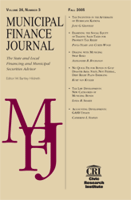Complete Issue
Author: Daniel Bergstresser.
Source: Volume 34, Number 02, Summer 2013 , pp.1-98(98)

< previous article |return to table of contents
Abstract:
On August 3, 2012, the Brandeis International Business School’s First Municipal Finance Conference brought together more than 200 practitioners and researchers to discuss recent research on municipal markets. One purpose of the conference was to start a conversation between and among academics, practitioners, and policymakers about the best research, research methods, and sources of data on municipal markets. The goal was to break down the silos that separate academics from practitioners, which can leave interested practitioners unaware of useful and state-of-the-art academic research and can leave the academic research community unaware of important developments in practice. The conference structure included 14 papers covering a broad range of topics. Authors were drawn mostly from different parts of the academic community, with a handful representing policymakers and practice. This issue of the Municipal Finance Journal includes two of the papers presented at the conference, as well as the discussions accompanying them. Additional papers will be published in the next issue of MFJ. Martin Luby and Tima Moldogaziev’s paper, “An Empirical Examination of the Determinants of Municipal Bond Underwriting Fees,” explores how underwriting fees are determined, focusing not just on the specific characteristics of the underwriter, but also on the financial advisor and—interestingly—on the nature of the interaction between the underwriter and financial advisor. The paper discusses bonds issued by Texas borrowers—bonds for which the Texas Bond Review Board collects and disseminates data on gross underwriting spreads. The rich data collected by the authors allow them to explore empirically the relationship between financial advisors, underwriters, and issuance costs. Among their intriguing results, they find that bond issues characterized by a “high-intensity” relationship between underwriter and advisor (one where the advisor and underwriter work together a great deal) are associated with higher issuance costs for issuers. The discussion article, by Daniel Bergstresser, notes that the authors’ paper furthers our understanding of the drivers of costs that issuers pay when they issue municipal bonds and that the authors’ key innovation is their focus on joint consideration of the financial advisor and the underwriter. Although the paper highlights the “devilish complexity of empirical work . . . , the authors are doing a vital job of pointing us in the direction of understanding these relationships and the impact that they can have.” Robert Doty’s paper, “Diversity and Default Risks of Municipal Bonds,” raises the important distinction between different types of municipal debt, highlighting the difference between general fund securities—backed only by the spending power of the municipalities’ general fund—and general obligation (GO) securities. Doty describes some particularly odd securities, such as “general obligation appropriation securities,” which are labeled as GO securities but which are subject to the annual appropriations process. Doty also highlights the importance, in evaluating municipal bonds, of considering whether the underlying statute authorizing the bond issuance gives bondholders the protection of a statutory lien, which guarantees that they will be paid even if the municipality attempts to file for Chapter 9 protection. The conference session was moderated by Bart Hildreth, whose discussion paper is provided here. Hildreth describes an exercise that he undertook after reading Doty’s paper. He went through 30 years of papers, books, and other writing on municipal bonds, more than 20 different documents in all, authored by a range of writers including law professors, attorneys, SEC staffers, and finance professors. Hildreth looked across these documents for their description of “general obligation” and noted, almost across the board, that these authors describe “GO” using the familiar language of the “full faith and credit” pledge. He noted that none of the references he consulted considered the existence of a statutory lien on taxes, which is turning out to be extremely important in the context of recent municipal bankruptcies.We hope that the readers of MFJ will find these papers thought-provoking, informative, and useful in their areas of interest and practice.Keywords: General obligation bonds, general fund securities, governmental utility revenue securities, special tax bonds, municipal bankruptcies, Financial advisor-underwriter relationship, underwriting spreads, bond characteristics, bond design
Affiliations:
1: Brandeis International Business School.